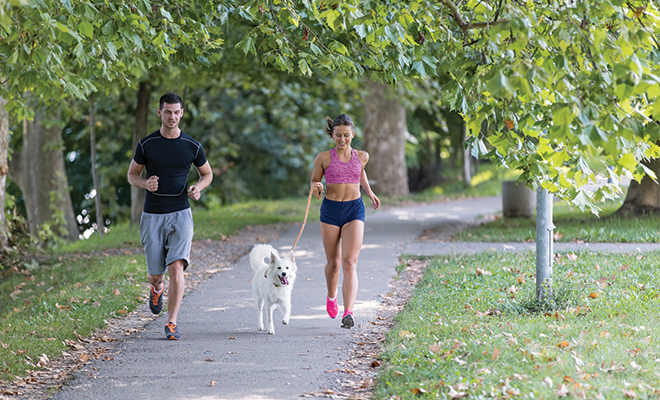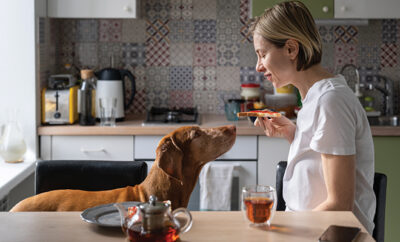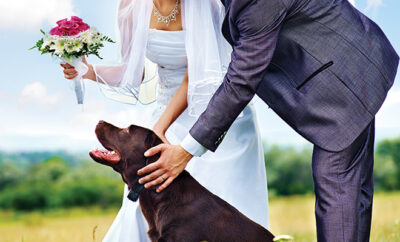
Create a Deeper Bond: Run with Your Dog
Running can be a great fitness activity for both humans and canines. A regular running program can help both you and your dog lose weight and strengthen your heart and lungs while decreasing stress and anxiety. Running together can also help you bond and improve the quality of your relationship with your pet.
Like humans, many dogs need training to be able to run longer distances. Also, some breeds are just not built for long runs. Before you and your pooch hit the road, it’s important to understand some basic facts about dogs and running.
Check Your Dog’s Age and Breed
Besides being healthy, a dog needs to be the right age for running. Experts say a dog should be at least 18 months old before starting to run long distances because a puppy’s bones are still developing and aren’t ready for more than walking. Also, older dogs may have arthritis and other issues that make running difficult.
The dog breeds that are best for running have legs that are relatively long compared to the length of their bodies. Some of the best running breeds are Labradors, golden retrievers and border collies. Short-legged, long dogs such as dachshunds and dogs from breeds with breathing problems, such as bulldogs and pugs, shouldn’t be taken on extended runs. Dogs with heavy coats, such as huskies, shouldn’t run in hot weather.
Consult your vet to be absolutely sure your dog is ready to start running. It’s the best way to be sure the exercise won’t do more harm than good. You may even get some useful training tips.
Health Benefits for Both
Many dogs have excess energy that needs to be burned off on a regular basis. Running is a great way to accomplish this. A dog will use different muscles when running compared to walking or fetching a ball. They also get more mental stimulation running outdoors than shut up indoors.
Of course, people receive all the same health benefits as their dog when running together. Many find they enjoy running more when their pet is by their side and they’re more motivated. The PEDIGREE Foundation reports that people who exercise with their dogs are more likely to stick with a routine long term.
Using a Loose Leash
If your dog is healthy and the right age and breed for running, take a critical look at his or her leash behavior. You don’t want to be tripped up or pulled off course if your dog isn’t trained to walk with a loose leash. Most dog training experts warn that retractable leashes increase the risk of accidents and recommend three- to six-foot leashes for running.
You’re at greater risk of tripping if your dog runs in front of you or weaves from side to side. Either side is fine for running as long as you are comfortable and stick to that side for consistency. If your dog isn’t loose-leash trained, try using treats and toys to reward your dog for staying at your side and letting the leash stay slack.
Training Your Dog to Run
Once you feel confident that your dog will behave while running, start running short distances to help your dog build endurance. Although your dog may seem like a natural athlete, you want to avoid pulled muscles and other injuries that come from running too far too soon. Our dogs can’t tell us when they’re tired, so we need to be aware of their body language and watch for excessive panting or signs of exhaustion.
Dogs need to be hydrated while running or they may resort to drinking from puddles and other standing water. Bring along a water bottle and give your dog a drink before and after the run. Be on the lookout for signs of thirst and exhaustion, such as slowing down, glazed eyes and foaming at the mouth, and slow down or take a break.
Tips for Running with Your Dog
Your dog may get distracted by a squirrel or need a bathroom break during a run, so don’t expect to break any personal records. Remember to be a good pet owner and clean up after your pet goes. Being on a run unfortunately doesn’t give you a free pass from picking up poop.
Your feet are protected by running shoes, but your pet is not so lucky. Be aware that the surface you run on could harm your dog’s paws. Avoid hot blacktop, ice and roadside trash that could contain broken glass. After a run, make sure that both you and your dog take time to cool down. Then check your dog’s paws for dirt and debris and clean with a warm rag to avoid irritations and infections. ■
Sources: pedigreefoundation.org, avma.org, runnersworld.com and akc.org.







